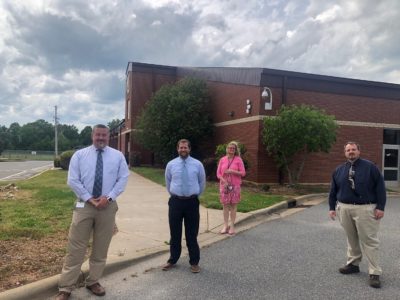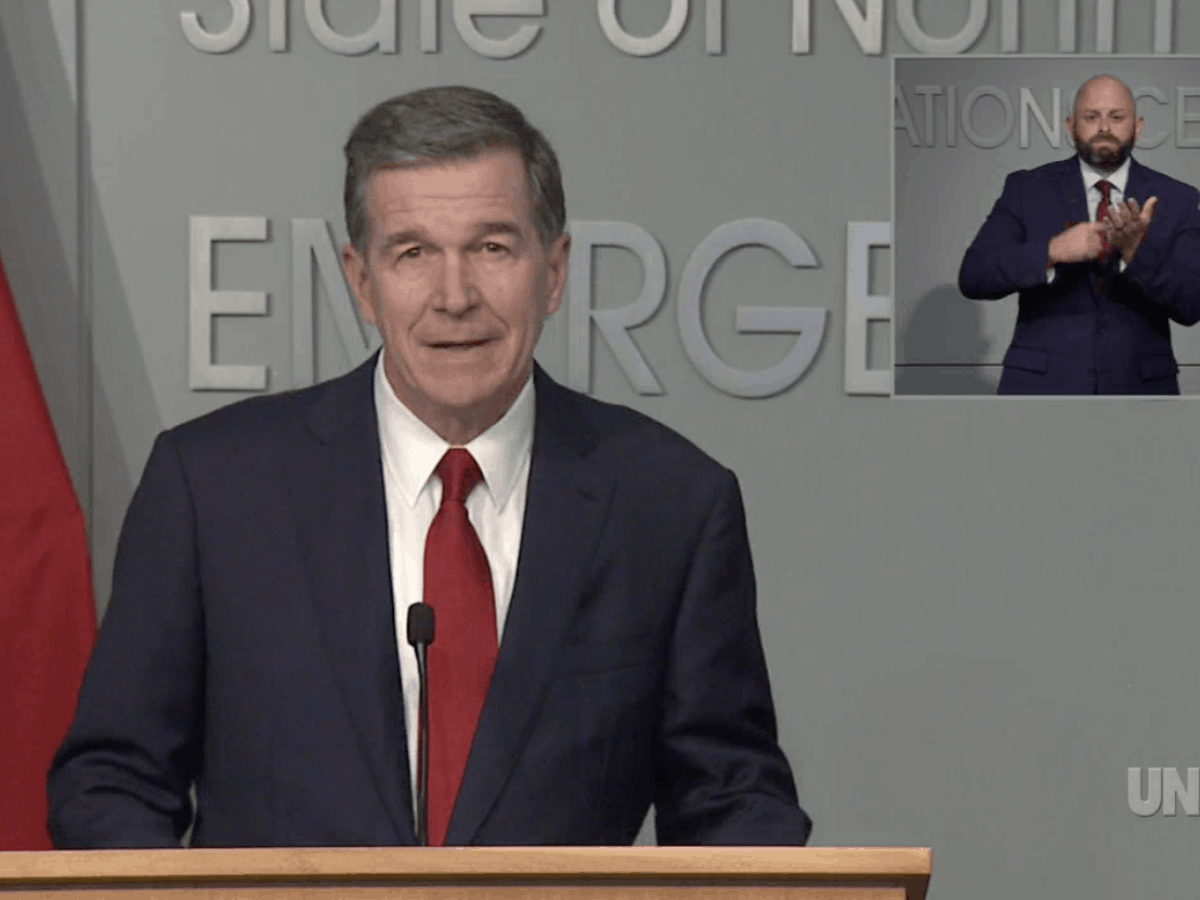

When schools reopen this fall, they will be either more spacious or completely empty under Gov. Roy Cooper’s plan for the coming school year.
Cooper announced today that schools will operate under plan B, which allows schools to open under a reduced capacity. Districts also have the option of opening under plan C, which will allow them to continue instruction through only remote learning. They cannot operate under plan A, which would have all students back in schools with minimal social distancing.
“There are no decisions more important than the ones about our children and our schools. This announcement today is the result of careful, collaborative, and painstaking work,” Cooper said, adding: “There is much risk in not going back to in-person school. We know that schools provide so much more than just academic lessons.”
Ever since school buildings closed due to COVID-19 in March, education leaders have been wondering what school would look like in the fall. Now that Cooper has made his announcement, districts will turn to implementing their plans.
Leaders from around the state responded to the governor’s announcement today with both support and criticism, while district superintendents continue to grapple with issues related to school funding, transportation, and logistics as they race to get ready for an August 17 start date.
Originally, plan B required schools to only operate at up to 50% capacity. The guidelines have now been revised to state that schools must limit the number of students and staff to the extent necessary to ensure 6 feet of separation whenever people are stationary.
The State Department of Health and Human Services (DHHS) has released a toolkit that addresses the recommendations and requirements for schools under plans B and C. According to a press release from Cooper’s office, the following recommendations and requirements apply to plan B.
Requirements
- Require face coverings for all teachers and students K-12
- Limit the total number of students, staff, and visitors within a school building to the extent necessary to ensure 6 feet distance can be maintained when students/staff will be stationary
- Conduct symptom screening, including temperature checks
- Establish a process and dedicated space for people who are ill to isolate and have transportation plans for ill students
- Clean and disinfect high-touch surfaces in the school and transportation vehicles regularly
- Require frequent hand washing throughout the school day and provide hand sanitizer at entrances and in every classroom
- Discontinue activities that bring together large groups
- Limit nonessential visitors and activities involving external groups
- Discontinue use of self-service food or beverage distribution
Recommendations
- Designate hallways and entrance/exit doors as one-way
- Keep students and teachers in small groups that stay together as much as possible
- Have meals delivered to the classroom or have students bring food back to the classroom if social distancing is not possible in the cafeteria
- Place physical barriers such as plexiglass at reception desks and similar areas
Cooper said that as part of plan B, the state wants districts to offer remote learning options for students who want them. The state is also giving every public school student, teacher, and school staff member at least five reusable, washable face coverings. Everybody will have to wear masks during school, even students. Additionally, in June, the state gave out a two-month supply of “thermometers, surgical masks, face shields and gowns for school nurses and delegated staff who provide health care to students,” according to a press release.
Cooper said that temperature checks will take place every day at school, and schools must find a way to isolate students who have symptoms. Additionally, school schedules must build in time for “frequent” hand washing and there must be regular cleaning of classrooms, buses, and other areas.
If the state’s COVID-19 trends get much worse between now and when schools reopen, Cooper said districts may have to open under plan C, which is fully remote learning, instead.
Mandy Cohen, secretary of DHHS, said that the state weighed the scientific evidence against the risks of COVID-19 when making this decision. She cited the fact that children are less susceptible, have weaker symptoms, and are less likely to spread COVID-19.
“We’ve never faced a pandemic like this one before. I know for all of us this has been a very stressful reality. I can’t tell you with certainty what the future holds,” she said, adding that the state would be in constant communication with school districts.
Cohen said there are extensive protocols if a student or staff member gets sick at a school, and that those protocols have been sent to school districts. She briefly laid out during the press conference that if a student is identified as having COVID-19, contact tracing would be done to determine who else had come in contact with the student.
“It doesn’t mean immediately that this school needs to close,” she said. “They may want to go beyond our protocol and do it. It depends on the situation.”
The State Board of Education approved in June guidance for schools reopening, including possible ways to handle holding school under the different plans proposed by the state.
The guidance document includes many possible scheduling configurations for keeping school going under plan B. Here are the first three.
Option A
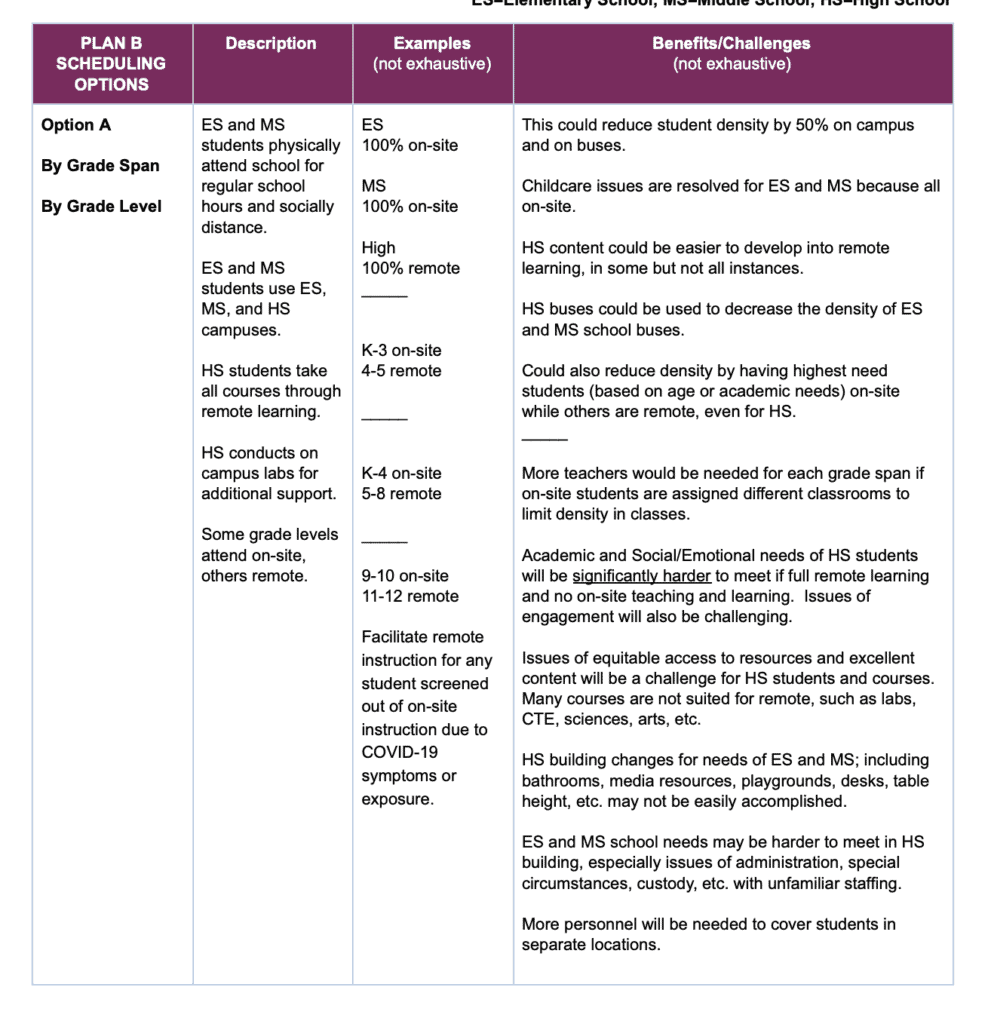

Option B
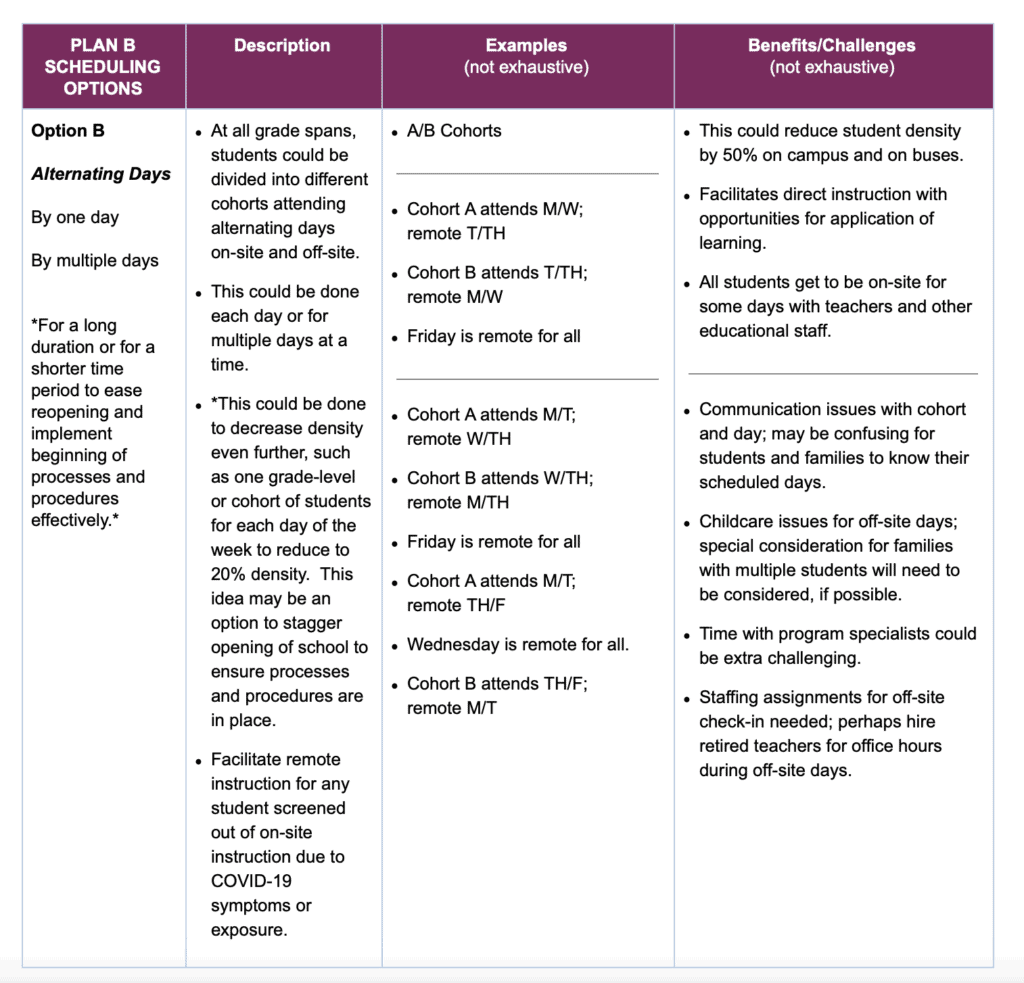

Option C
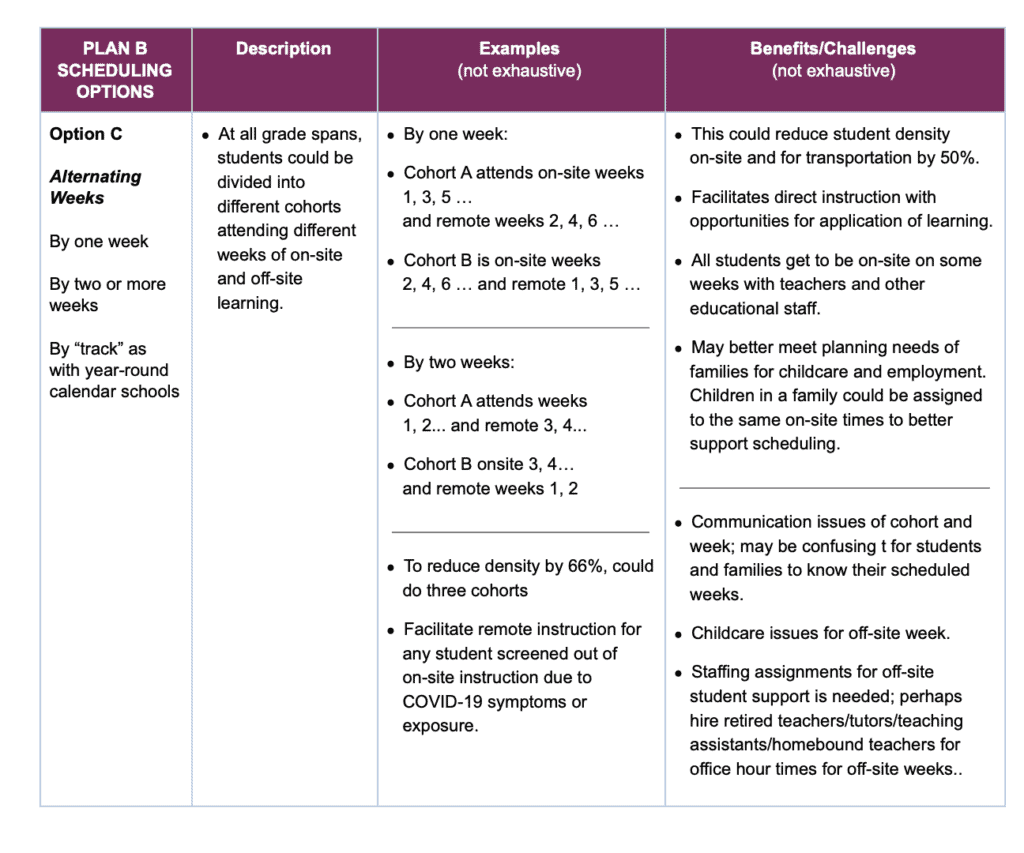

You can see the rest of the possible configurations on pages 14, 15, and 16 of the guidance document.
Originally under plan B, school buses also had to operate at reduced capacity so that six feet of distance could be kept between all students. But the social distancing guidance changed so that there can now be at least one student per seat.
Cooper was asked during the press conference about a law passed by the General Assembly that requires schools to have their first five days of school in person with no option of remote learning.
“We have a letter from the Department of Justice from the Attorney General’s office stating that what we have done here is in compliance with the law overall, that the General Assembly has recognized that there can be emergency situations where students will need to be out of school and in remote learning. So this plan is in compliance with the law,” he said.
Legislation passed by the House last week would have eliminated that part of the law as well, but the Senate never took it up before lawmakers adjourned until September.
So now the state has a plan for school in the fall. But how will that look in reality?
Facts on the ground
Jack Hoke, executive director of the North Carolina School Superintendents’ Association, said that district leaders around the state have been preparing for all three plans since they were announced, so they are ready to pivot to implementing the plans now announced by the governor.
“They will be prepared and look forward to getting our students back into school in some form or fashion,” he said.
He also said he’s happy that the announcement has finally been made.
“Parents will know what it’s going to look like so everybody can make plans now. We start school in about 33 days, so this will give us a little more lead time,” he said.
In an interview, State Board of Education Chair Eric Davis said that over the last few weeks, education leaders and the governor’s office have been thinking through a number of ideas on how to bring students back to school. One of them was to let districts who felt prepared to do plan A — having all students back in schools with minimal social distancing — go ahead and make that decision.
There are multiple counties in North Carolina that have fewer than 100 cases of COVID-19. The map below from DHHS’s website shows the prevalence of COVID-19 around the state.
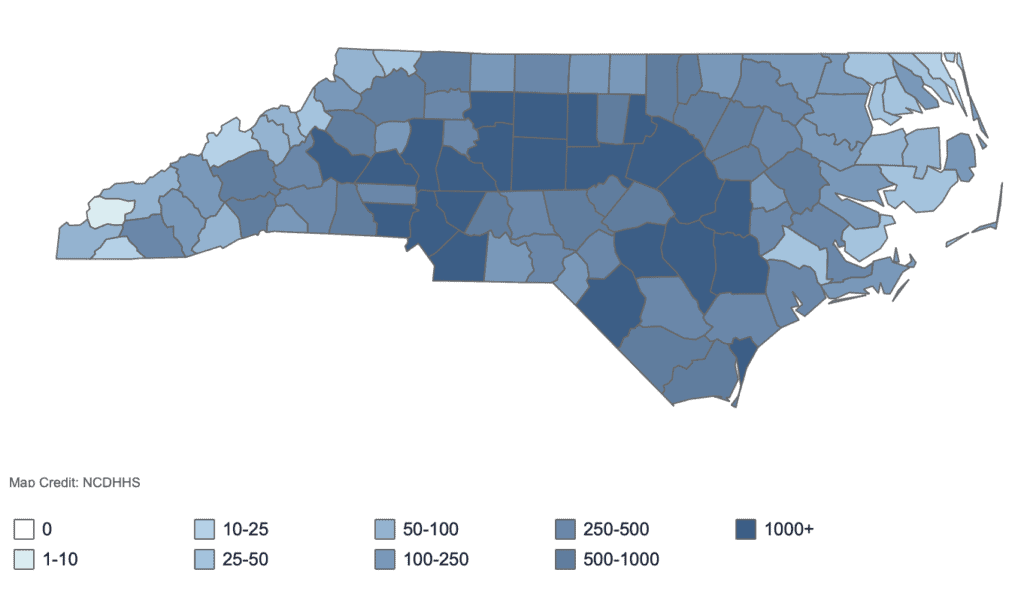

However, under today’s decision, plan A is not available to any school districts.
“My colleagues and I have a range of perspectives on which reopening plan we should pursue, and that range I think is consistent with the variety of opinions across the constituents we serve,” Davis said.
He added, however, that he and all his colleagues are united around the idea that the best place for a child is in the classroom.
Some districts, like Wake County Public Schools, had already decided on their plans prior to the governor’s announcement. The district is essentially dividing their student population into thirds. One-third of students will attend schools for one week, while the rest of the students do remote learning. That one-third will then rotate out for the second and third week, while other groups of students rotate in.
Transylvania County Schools Superintendent Jeff McDaris said he was hopeful that plan A would be the one chosen, but not just because he wanted a return to normalcy. Transylvania County only has 58 cases of COVID-19 and one death, according to the latest data from DHHS.
“I think the bigger reason that I was hoping for Plan A is really not just the learning aspect but also the social-emotional aspect. Our students have been out for a very long time … some are struggling,” he said. “You lose that connection. Relationships are critical in learning. The longer you can’t maintain those normal types of relationships, the more challenging it can become for students and families.”
But that doesn’t mean he’s disappointed or upset about the governor’s announcement either.
“That said, I do agree that it’s wise not to go full bore option A right away, because what we’re seeing in the rural areas, we’re seeing numbers jump,” he said.
Transylvania County was sitting in the single digits for a long time, he said, but just in the past week, the county jumped up to the level it’s at now.
The district hasn’t settled on a firm plan yet. He said he is meeting with the local board of education Monday night and will likely announce Tuesday whether the district will do plan B or C.
Watauga County has had relatively low rates of COVID-19 compared to some other counties in the state. The latest data from DHHS puts them at 128 cases with zero deaths. But Watauga County Schools Superintendent Scott Elliott said the case number has doubled in the last couple of weeks.
“I might have been hopeful for a plan A several weeks ago, but increasingly I’ve come to realize that a plan B or a plan C was more likely,” he said, adding later: “We are prepared to accept the governor’s announcement and proceed accordingly.”
The plan for the district right now is to cut the student population in half. Half of the students will attend in person for the first two days of the week. Then Wednesdays will be a remote learning day for all students. Then the other half of the students will attend schools on Thursday and Friday.
Additionally, the district has launched the Watauga Virtual Academy for those families who don’t feel safe having their students in school.
Elliott said a number of teachers — about 10% — have expressed concerns about returning themselves, so he’s hoping to match them with the students who won’t be returning so they can all do online education.
“I don’t know what I expected or what I hoped for,” Elliott said of the governor’s announcement. “I have the same conflicted mixed feelings of everyone else.”
Elliot has two school-aged children himself, and his wife is a teacher. He said he understands well the fears of teachers and parents.
“There just does not seem to be a perfect solution, and we’re all going to have to work together as we navigate what seem to be constant changes,” he said.
Stephen Basnight, superintendent of Hyde County Schools, said his district has been planning for plan C all along, but not necessarily because that’s what the district wanted to do.
“Our focus was if you plan to do remote instruction and you have students in a face-to-face environment, that’s a bonus,” he said. “You can actually teach a remote lesson face to face, but it doesn’t work the other way.”
Hyde County is the smallest district in the state with 590 students. According to the latest data from DHHS, the district has had 34 cases of COVID-19 with no deaths. But that doesn’t mean Basnight is unconcerned about safety. It’s a big concern, though he said he’s not really sure which of the governor’s plans would be best for students.
“I’m not in favor of being in a situation where we make our students and our staff guinea pigs in an experiment to see if whatever plan is going to work,” he said. “I would rather that we be safe, and we put all of those things … in place that are going to make sure and ensure that they are safe.”
With such a small student population, Basnight said he believes Hyde County can adhere to the reduced capacity requirements under plan B and still have all kids in school by utilizing school buildings and classrooms differently.
“Based on everything we’ve seen, we can do that,” he said.
Buses
While districts are figuring out how to get students in classroom, they’re also struggling with how to get them to school. And that can be a big hurdle, according to some education leaders.
In June, EducationNC talked with Patrick Miller, superintendent of Greene County Schools. He said that for his relatively small county, busing posed a huge challenge.
Greene County has just under 2,900 students. If buses are required to run at reduced capacity, that could present a problem for the district. The shortest route district buses take is an hour. The longest is over two hours. Limiting the number of students who can ride the bus would require tiered busing: multiple trips to get all the students. Miller estimated probably three.
That means if buses started at 6 a.m., the first group of students could possibly get to school at 8, the second at 10, and the next group at 12. Miller said there is no way the district could even stagger the start time of school to accommodate this reality. Also, Greene County’s buses usually only make one trip in the morning to get kids and bring them to school. This will triple their work. And there is no extra money for school transportation to help meet this possibility.
But in a more recent interview, Miller said the revised busing guidelines have alleviated the burden some. So has the plan his district has come up with for the fall.
Based on information collected by the district, Miller estimates that about 40% of families in his district would prefer remote learning. So similar to some other counties, Greene County is going to have a virtual school that will be available to them. Because of that, fewer students will need to ride the buses. Coupled with the change in guidelines on how many students can be on a bus, Miller said he thinks the district can make it work.
While Basnight might have the in-school situation figured out for Hyde County, buses are more challenging. Hyde also has some two-hour bus routes.
“We’re not going to be back to school until 11:30 with our second run,” he said. “And that’s almost the time that we’re going to have to turn around and take the students back home.”
Another issue related to busing is transportation funding from the state. Basnight said districts are rated based on how many routes buses run and how full buses are. Basically, the more they run full buses, the more money they get.
But with fewer numbers of students on the buses and multiple runs, the district’s rating will go down and the district will get less money from the state. Meanwhile, since buses are running more often, the district’s transportation costs are increasing. And while the change in social distancing guidelines on buses helps, Basnight said it doesn’t solve his problems.
“We’re still struggling with that,” he said. “How many kids to get on buses. How many times a day we’re going to have to run the buses to do that. And the bottom line, how we’re going to pay for it.”
Lower enrollment?
Another issue that faces school districts under almost any plan the governor could have chosen is a possible decrease in their budgets. Schools are allocated money by the state based on average daily membership (ADM). Basically, districts get money based on the number of students they have attending school at particular points in time. The districts get a budget based on what enrollment they’re projected to have, and then the state adjusts their budget after checking in early fall to see how many students they actually have.
When EducationNC spoke with Miller in June, he said he was seeing estimates that 18% to 20% of students aren’t going to return even if schools are open. He said that if that happened in his county, he may end up having to lay off up to 100 teachers.
“How disruptive is that to students and families during the school year if we have to combine and collapse classes?” he asked in June. “It’s just nightmare scenario after nightmare, and I don’t know how anybody can plan for them.”
Elliott said this issue is a big concern for his district as well, particularly since he is going to need staff available to provide all the different options students are going to need this fall. When his district sent out a survey asking parents if they would send their kids back to school under plan A, 25% of those who responded said they would not. There was no question on the survey about plan B, but it seems likely that there will still be a good amount of parents who are uncertain about letting their kids return.
“We asked repeatedly for the legislature to consider flexibility with when enrollment is captured and how funding is decided, or to give us a hold harmless, but it was never addressed,” he said.
Cooper was asked about this issue during the press conference, and he said that lawmakers need to do more for the state’s public schools.
“We know that opening our schools under a plan B is going to cost our schools more, not less,” he said. “In addition, the state needs to do a lot better with salaries for our teachers and our school support personnel.”
Cooper said he wants to work with the General Assembly on better funding as well as the ADM issue when lawmakers come back in September. He also said state leaders hope to see a federal congressional package by then that would help support the state’s public schools.
Reactions from lawmakers, education leaders
Leaders from the around the state responded after Cooper announced his plan for schools in the fall.
Cooper’s press release included statements from both the North Carolina Association of School Administrators as well as the North Carolina School Boards Association.
“While all school re-entry plans have their challenges during this pandemic, our superintendents, principals, and other school leaders will continue to prioritize student and staff safety in reopening schools under the cautious parameters outlined today by the Governor,” said North Carolina Association of School Administrators Executive Director Katherine Joyce. “We look forward to continuing work with the Governor, the General Assembly, and other state leaders to ensure our schools have the support needed to get student learning back on track in the safest manner possible in each local district.”
Brenda Stephens, president of the North Carolina School Board Association, said in her statement that she understands that the decision was a hard one, but now school districts and board can start moving ahead with their reopening plans.
“While the current situation may not be ideal for all, I’m confident North Carolina’s educators will continue to provide students with the best education possible,” she said in the statement.
Additionally, the North Carolina Association of Educators sent out a statement in support of the governor’s decision after his announcement.
“Educators want to be back in school buildings. We miss and value the relationships we have with students and their families. The careful approach Governor Cooper has taken in all of his re-opening decisions has been deeply appreciated, and while we understand that this was a difficult choice, we must make the safety of our educators and students the first priority,” said Tamika Walker Kelly, president of the North Carolina Association of Educators, in a press release.
She went on to say that the General Assembly has refused to appropriate the resources necessary to help schools open safely.
“This General Assembly must step up and do their jobs to provide the necessary funding for public schools so that we as educators can do our jobs to safely educate all of North Carolina’s students,” she said.
Sen. Deanna Ballard, R-Watauga, a chair of both the Senate education and education appropriations committees, put out a press release today prior to the governor’s announcement in which she touted the resources that lawmakers have provided.
“In our coronavirus relief packages, we’ve prioritized remote learning and support services many families rely on during the school year,” she said in the statement. “Even in the middle of an unprecedented financial and public health crisis, we have maintained historic levels of funding for schools and provided pay raises and bonuses to our teachers.”
She went on to list some of the things lawmakers have funded.
- $75 million for meals;
- $10 million for mental health support services;
- $12 million for internet connectivity;
- $35 million for electronic devices so students can access online learning;
- $9 million for the GREAT program to establish more broadband internet services in under-served communities;
- $70 million for summer learning programs;
- $7 million for PPE.
State Superintendent Mark Johnson said in a statement that he was glad the 50% occupancy limit in schools was lifted but would have preferred a plan “built around local control.”
“I want us to ensure that students and educators who want to safely return to in-person learning have that opportunity while schools also provide high-quality alternatives for students and teachers who may not yet feel comfortable returning to classrooms,” he said. “I don’t support everything in Governor Cooper’s plan, but I am 100% supportive of North Carolina’s students, educators, and families and that we all work together to support our schools the best we can.”
He went on to say that last week, numerous organization, including the American Academy of Pediatrics, National Education Association, and others issued a joint statement “discouraging a one-size-fit-all approach.”
“Local school leaders, with the guidance of state health leaders and with input from their educators and parents, should determine the capacities of their districts to adapt safety protocols to make in-person learning safe and feasible, as the medical professionals, superintendents, and other education stakeholders suggest,” Johnson said.
Senate President Pro Tempore Phil Berger, R-Rockingham, and House Speaker Tim Moore, R-Cleveland, both released statements critical of the governor’s decision.
Berger said that the governor’s plan will make inequities in schools harder to fix and leave some students further behind.
“Gov. Cooper’s plan gets students halfway to where they need to be. But much like jumping over a creek, halfway doesn’t cut it,” he said in his statement, adding later: “The Governor permits parents to choose full remote learning — he must also permit parents to choose full in-person learning as well.”
In the statement, Berger also questioned Cooper’s decisions around mask requirements.
“I also have serious questions about the requirement for masks on five-year-olds, which contradicts the Cooper Administration’s own guidance for child care centers,” he said in the statement. “What happens when a kindergartner removes a mask? Does the Governor really expect teachers to have any chance of enforcing this mandate?”
Moore criticized Cooper’s handling of COVID-19 when it comes to the closing down of the state’s economy and protecting nursing homes, before launching into his critique of the school reopening plan.
“Today’s announcement that classrooms will remain closed to students either periodically or completely exacerbates the administration’s economic and public health failures while adding even more uncertainty for struggling families in North Carolina,” he said in the release.
The North Carolina Pediatric Society released a press release today addressing the guidance recently released by the American Academy of Pediatrics (AAP). The NC Pediatric Society is the state affiliate chapter of the American Academy of Pediatrics.
The AAP said in its guidance that there should be a “goal of having students physically present in school,” but “with careful measures to keep students and staff safe, and with flexibility to adapt as needed to the community’s prevalence of COVID-19.”
The North Carolina Pediatric Society reiterated those points in its press release and said it agrees with the recommendations because it is is supported by what is known about COVID-19, including that children are less likely to get and spread it, and that students learn best in person.
The release says, however, that the position isn’t a blanket recommendation.
“While the AAP guideline recommends in-person education be available, it also recognizes that COVID-19 remains a very real, active threat to health and that decisions need to consider many factors, including the level of circulating virus. School leaders will need to work with public health officials to balance the health benefits of in-person education with the risks of COVID-19 in our communities,” the release states.
The organization also said in the press release that reopening schools shouldn’t be about politics.
“Getting children back to school should not be a political issue. It is a health, social, economic and equity issue. Ideal scenario is that we have no COVID-19. Reality is that we do. Given this reality, we must use the evidence and research we have to make the best decision for our children and our communities when it comes to re-opening schools,” the release states.
Dr. Theresa Flynn, a practicing pediatrician who serves on the board of directors for the North Carolina Pediatric Society, spoke at the governor’s press conference today, saying that the governor’s plan does a good job balancing health and safety with the need to have students in school.
The two candidates vying to replace Johnson as state superintendent of public instruction also released statements about the governor’s decision. The Republican candidate, Catherine Truitt, was critical of his decision, while the Democratic candidate Jen Mangrum was supportive.
With a decision on schools made, Davis said in the press conference that the best thing everybody can do now is make sure they adhere to safety recommendations relating to COVID-19.
“Regardless of how we may feel about this virus or how tired we may be about how our lives have been disrupted, our students, teachers and staff need us to lead by wearing our masks, washing our hands, and staying 6 feet apart so that they can return to school,” he said.


